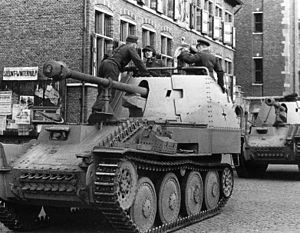Marder III
| Marder III | |
|---|---|

Marder III Ausf. M
|
|
| Type | Tank destroyer |
| Place of origin | Nazi Germany |
| Service history | |
| In service | 1942–1945 |
| Used by | Nazi Germany |
| Wars | World War II |
| Production history | |
| Designed | 1942 |
| Manufacturer | BMM (ČKD) |
| Produced | 1942–1944 |
| Number built |
1736 produced and converted |
| Specifications | |
| Weight | 10,670 kg (23,523 lbs) |
| Length | 4.65 m (15 ft 3 in) |
| Width | 2.35 m (7 ft 9 in) |
| Height | 2.48 m (8 ft 2 in) |
| Crew | 4 |
|
|
|
| Armor | 10 - 50 mm |
|
Main
armament |
7.62 cm PaK 36(r) or 7.5 cm PaK 40 |
|
Secondary
armament |
7.92 mm MG 37(t), MG 34 or MG 42 |
| Engine | Praga Typ TNHPS/II water-cooled, 6-cylinder gasoline, 7.75 l 125-150 PS (123-148 hp, 92-110 kW) |
| Power/weight | 14.1 PS (10.3 kW) / tonne |
| Suspension | leaf spring |
| Ground clearance | 40 cm (1 ft 4 in) |
|
Operational
range |
190-210 km |
| Speed | 35-42 km/h |
1736 produced and converted
Sd. Kfz. 139: 344 produced
Sd.Kfz. 138, Ausf. H: 275 produced, 175 converted
Marder III was the name for a series of World War II German tank destroyers. They mounted either Soviet 76.2mm F-22 Model 1936 divisional field guns, or German 7.5 cm PaK 40, in an open-topped cupola on top of the chassis of the Panzer 38(t). They offered little protection to the crew, but added significant firepower compared to contemporary German tanks. They were in production from 1942 to 1944 and served on all fronts until the end of the war, along with the similar Marder II. The German word Marder means "marten" in English.
Even in the early stages of Operation Barbarossa, the Wehrmacht felt the need for a more mobile and more powerful anti-tank solution than the existing towed anti-tank guns, such as the Pak 36, or self-propelled tank destroyers such as the Panzerjäger I. This need became urgent in 1942, when anti-tank shells failed to penetrate the armor of new Soviet tanks such as the T-34 and KV-1.
As an interim solution, it was decided to use captured French vehicles, such as the Lorraine (Marder I), obsolete tanks, such as the German Panzer II (Marder II), and Czech-supplied Panzer 38(t) (Marder III) as the base for makeshift tank destroyers. The result was the Marder series, which were armed with either captured Soviet 76.2mm F-22 Model 1936 divisional field guns, or German 7.5 cm PaK 40 anti-tank guns for later versions. Due to weight and space constraints of these small chassis, the Marder series were not fully armored. Thin upper armor protection against just shrapnel and small arms fire was provided only for the front and sides. All Marder series had open tops. Some were issued with canvas tops to protect the crew from the elements. In this regard, the Marder was more of a gun carriage than a proper Panzerjäger that could exchange shells with enemy tanks.
...
Wikipedia
